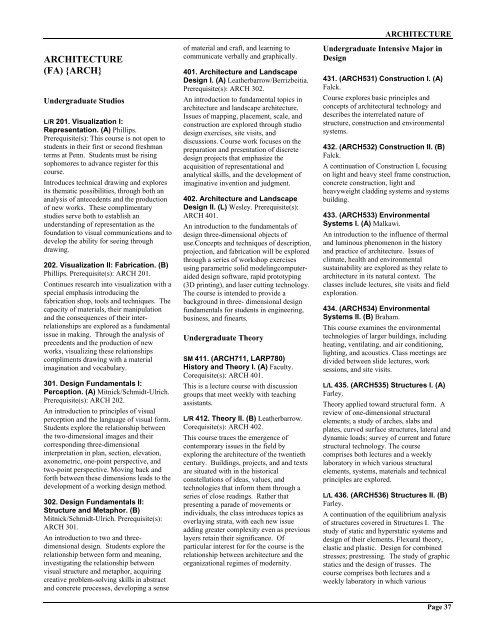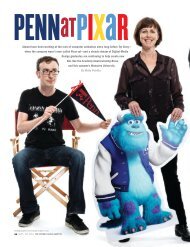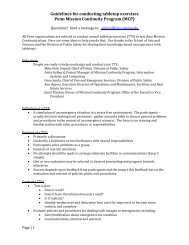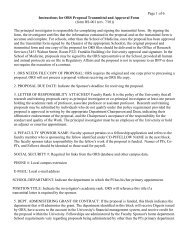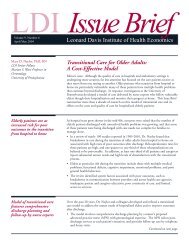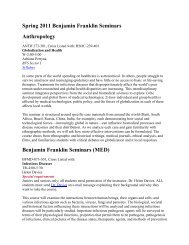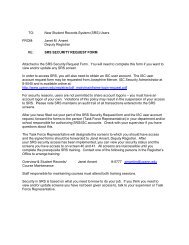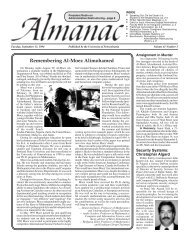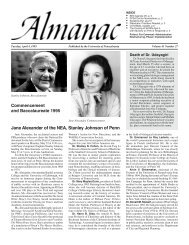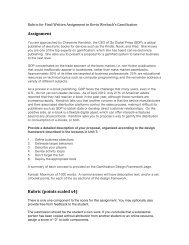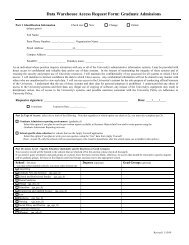2009-2010 COURSE REGISTER - University of Pennsylvania
2009-2010 COURSE REGISTER - University of Pennsylvania
2009-2010 COURSE REGISTER - University of Pennsylvania
You also want an ePaper? Increase the reach of your titles
YUMPU automatically turns print PDFs into web optimized ePapers that Google loves.
ARCHITECTURE<br />
(FA) {ARCH}<br />
Undergraduate Studios<br />
L/R 201. Visualization I:<br />
Representation. (A) Phillips.<br />
Prerequisite(s): This course is not open to<br />
students in their first or second freshman<br />
terms at Penn. Students must be rising<br />
sophomores to advance register for this<br />
course.<br />
Introduces technical drawing and explores<br />
its thematic possibilities, through both an<br />
analysis <strong>of</strong> antecedents and the production<br />
<strong>of</strong> new works. These complimentary<br />
studies serve both to establish an<br />
understanding <strong>of</strong> representation as the<br />
foundation to visual communications and to<br />
develop the ability for seeing through<br />
drawing.<br />
202. Visualization II: Fabrication. (B)<br />
Phillips. Prerequisite(s): ARCH 201.<br />
Continues research into visualization with a<br />
special emphasis introducing the<br />
fabrication shop, tools and techniques. The<br />
capacity <strong>of</strong> materials, their manipulation<br />
and the consequences <strong>of</strong> their interrelationships<br />
are explored as a fundamental<br />
issue in making. Through the analysis <strong>of</strong><br />
precedents and the production <strong>of</strong> new<br />
works, visualizing these relationships<br />
compliments drawing with a material<br />
imagination and vocabulary.<br />
301. Design Fundamentals I:<br />
Perception. (A) Mitnick/Schmidt-Ulrich.<br />
Prerequisite(s): ARCH 202.<br />
An introduction to principles <strong>of</strong> visual<br />
perception and the language <strong>of</strong> visual form.<br />
Students explore the relationship between<br />
the two-dimensional images and their<br />
corresponding three-dimensional<br />
interpretation in plan, section, elevation,<br />
axonometric, one-point perspective, and<br />
two-point perspective. Moving back and<br />
forth between these dimensions leads to the<br />
development <strong>of</strong> a working design method.<br />
302. Design Fundamentals II:<br />
Structure and Metaphor. (B)<br />
Mitnick/Schmidt-Ulrich. Prerequisite(s):<br />
ARCH 301.<br />
An introduction to two and threedimensional<br />
design. Students explore the<br />
relationship between form and meaning,<br />
investigating the relationship between<br />
visual structure and metaphor, acquiring<br />
creative problem-solving skills in abstract<br />
and concrete processes, developing a sense<br />
<strong>of</strong> material and craft, and learning to<br />
communicate verbally and graphically.<br />
401. Architecture and Landscape<br />
Design I. (A) Leatherbarrow/Berrizbeitia.<br />
Prerequisite(s): ARCH 302.<br />
An introduction to fundamental topics in<br />
architecture and landscape architecture.<br />
Issues <strong>of</strong> mapping, placement, scale, and<br />
construction are explored through studio<br />
design exercises, site visits, and<br />
discussions. Course work focuses on the<br />
preparation and presentation <strong>of</strong> discrete<br />
design projects that emphasize the<br />
acquisition <strong>of</strong> representational and<br />
analytical skills, and the development <strong>of</strong><br />
imaginative invention and judgment.<br />
402. Architecture and Landscape<br />
Design II. (L) Wesley. Prerequisite(s):<br />
ARCH 401.<br />
An introduction to the fundamentals <strong>of</strong><br />
design three-dimensional objects <strong>of</strong><br />
use.Concepts and techniques <strong>of</strong> description,<br />
projection, and fabrication will be explored<br />
through a series <strong>of</strong> workshop exercises<br />
using parametric solid modelingcomputeraided<br />
design s<strong>of</strong>tware, rapid prototyping<br />
(3D printing), and laser cutting technology.<br />
The course is intended to provide a<br />
background in three- dimensional design<br />
fundamentals for students in engineering,<br />
business, and finearts.<br />
Undergraduate Theory<br />
SM 411. (ARCH711, LARP780)<br />
History and Theory I. (A) Faculty.<br />
Corequisite(s): ARCH 401.<br />
This is a lecture course with discussion<br />
groups that meet weekly with teaching<br />
assistants.<br />
L/R 412. Theory II. (B) Leatherbarrow.<br />
Corequisite(s): ARCH 402.<br />
This course traces the emergence <strong>of</strong><br />
contemporary issues in the field by<br />
exploring the architecture <strong>of</strong> the twentieth<br />
century. Buildings, projects, and and texts<br />
are situated with in the historical<br />
constellations <strong>of</strong> ideas, values, and<br />
technologies that inform them through a<br />
series <strong>of</strong> close readings. Rather that<br />
presenting a parade <strong>of</strong> movements or<br />
individuals, the class introduces topics as<br />
overlaying strata, with each new issue<br />
adding greater complexity even as previous<br />
layers retain their significance. Of<br />
particular interest for for the course is the<br />
relationship between architecture and the<br />
organizational regimes <strong>of</strong> modernity.<br />
ARCHITECTURE<br />
Undergraduate Intensive Major in<br />
Design<br />
431. (ARCH531) Construction I. (A)<br />
Falck.<br />
Course explores basic principles and<br />
concepts <strong>of</strong> architectural technology and<br />
describes the interrelated nature <strong>of</strong><br />
structure, construction and environmental<br />
systems.<br />
432. (ARCH532) Construction II. (B)<br />
Falck.<br />
A continuation <strong>of</strong> Construction I, focusing<br />
on light and heavy steel frame construction,<br />
concrete construction, light and<br />
heavyweight cladding systems and systems<br />
building.<br />
433. (ARCH533) Environmental<br />
Systems I. (A) Malkawi.<br />
An introduction to the influence <strong>of</strong> thermal<br />
and luminous phenomenon in the history<br />
and practice <strong>of</strong> architecture. Issues <strong>of</strong><br />
climate, health and environmental<br />
sustainability are explored as they relate to<br />
architecture in its natural context. The<br />
classes include lectures, site visits and field<br />
exploration.<br />
434. (ARCH534) Environmental<br />
Systems II. (B) Braham.<br />
This course examines the environmental<br />
technologies <strong>of</strong> larger buildings, including<br />
heating, ventilating, and air conditioning,<br />
lighting, and acoustics. Class meetings are<br />
divided between slide lectures, work<br />
sessions, and site visits.<br />
L/L 435. (ARCH535) Structures I. (A)<br />
Farley.<br />
Theory applied toward structural form. A<br />
review <strong>of</strong> one-dimensional structural<br />
elements; a study <strong>of</strong> arches, slabs and<br />
plates, curved surface structures, lateral and<br />
dynamic loads; survey <strong>of</strong> current and future<br />
structural technology. The course<br />
comprises both lectures and a weekly<br />
laboratory in which various structural<br />
elements, systems, materials and technical<br />
principles are explored.<br />
L/L 436. (ARCH536) Structures II. (B)<br />
Farley.<br />
A continuation <strong>of</strong> the equilibrium analysis<br />
<strong>of</strong> structures covered in Structures I. The<br />
study <strong>of</strong> static and hyperstatic systems and<br />
design <strong>of</strong> their elements. Flexural theory,<br />
elastic and plastic. Design for combined<br />
stresses; prestressing. The study <strong>of</strong> graphic<br />
statics and the design <strong>of</strong> trusses. The<br />
course comprises both lectures and a<br />
weekly laboratory in which various<br />
Page 37


